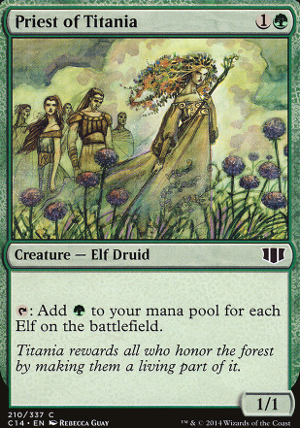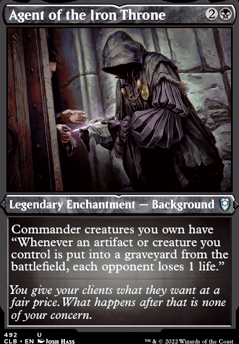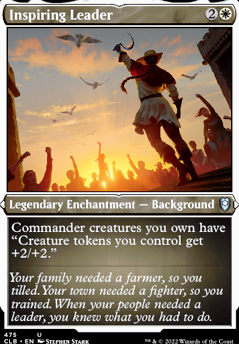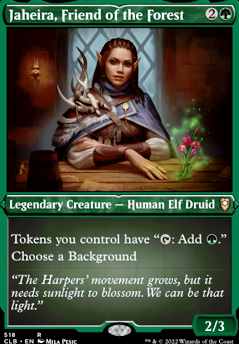
Ballad of the Two Nations (Jaheira EDH)
Commander / EDH* BGW (Abzan, Junk) Elves Enchantment Lifegain Sacrifice Tokens
| Date added | 4 years |
| Last updated | 5 months |
| Legality | This deck is not Commander / EDH legal. |
| Rarity (main - side) | 8 - 0 Mythic Rares 51 - 0 Rares 22 - 0 Uncommons 20 - 0 Commons |
| Cards | 134 |
| Avg. CMC | 3.41 |
| Tokens | Copy Clone, Elf Druid 1/1 G, Elf Warrior 1/1 G, Elf Warrior 1/1 GW, Emblem Tyvar Kell, Soldier 1/1 W, Voja |
| Folders | EDH current decks |
| Votes | |
| Ignored suggestions | |
| Shared with | |
| Views |
Green (65)
- 1x Beast Whisperer
- 1x Command Tower
- 1x Concordant Crossroads
- 1x Copperhorn Scout
- 1x Elven Ambush
- 1x Elvish Archdruid
-
1x
Elvish Warmaster

- 1x Essence Warden
- 1x Exotic Orchard
- 1x Ezuri, Renegade Leader
- 18x Forest
- 1x Freyalise, Llanowar's Fury
- 1x Fyndhorn Elves
- 1x Genesis Wave
- 1x Glorious Sunrise
- 1x Growing Rites of Itlimoc Flip
- 1x Imperious Perfect
- 1x Joiner Adept
- 1x Joraga Treespeaker
- 1x Kindred Summons
-
1x
Llanowar Elves

- 1x Lys Alana Huntmaster
- 1x Marwyn, the Nurturer
- 1x Nullmage Shepherd
- 1x Oracle of Mul Daya
- 1x Overwhelming Stampede
- 1x Paradise Druid
-
1x
Parallel Lives

- 1x Path of Ancestry
- 1x Priest of Titania
- 1x Quirion Ranger
- 1x Reclamation Sage
-
1x
Reliquary Tower

- 1x Return of the Wildspeaker
- 1x Rofellos's Gift
- 1x Song of the Dryads
- 1x Sylvan Library
- 1x Sylvan Ranger
- 1x Thriving Grove
- 1x Timberwatch Elf
- 1x Unclaimed Territory
- 1x Vernal Equinox
- 1x Wave of Vitriol
- 1x Wellwisher
- 1x Windswift Slice
- 1x Wolverine Riders
-
1x
Wood Elves

- 1x Wrap in Vigor
White (33)
- 1x Brushland
- 1x Collective Blessing
- 1x Congregate
- 1x Deafening Silence
- 1x Emmara Tandris
- 1x Fanatical Devotion
- 1x Fortified Village
- 1x Fumigate
- 1x Glare of Subdual
- 1x In the Trenches
- 1x Join Shields
- 1x Martyr's Bond
- 1x Mercy Killing
- 1x Moon-Blessed Cleric
- 7x Plains
- 1x Queen Allenal of Ruadach
- 1x Rhys the Redeemed
- 1x Rumor Gatherer
- 1x Selvala, Explorer Returned
- 1x Shield of the Oversoul
- 1x Sigil of the Nayan Gods
-
1x
Sterling Grove

- 1x Sundering Growth
- 1x Sungrass Prairie
- 1x Temple Garden
- 1x Temple of Plenty
- 1x Tolsimir Wolfblood
Black (33)
- 1x Deadbridge Chant
- 1x Elderfang Venom
- 1x Elvish Dreadlord
- 1x Essence Pulse
- 1x Glissa Sunslayer
- 1x Jarad, Golgari Lich Lord
- 1x Kagha, Shadow Archdruid
- 1x Koma's Faithful
- 1x Lathril, Blade of the Elves
- 1x Lich's Mastery
- 1x Llanowar Wastes
- 1x Moldervine Reclamation
- 1x Mortality Spear
- 1x Necroblossom Snarl
- 1x Ochran Assassin
- 1x Poison-Tip Archer
- 1x Rhys the Exiled
- 1x Rise of the Witch-king
- 1x Ruthless Winnower
- 1x Skemfar Avenger
- 8x Swamp
- 1x Temple of Malady
- 1x Tyvar Kell
- 1x Tyvar, Jubilant Brawler
- 1x Underrealm Lich
- 1x Viridescent Bog
Suggestions
Updates Add
Comments
Attention! Complete Comment Tutorial! This annoying message will go away once you do!
Important! Formatting tips — Comment Tutorial — markdown syntax
Please login to comment
| Date added | 4 years |
| Last updated | 5 months |
| Legality | This deck is not Commander / EDH legal. |
| Rarity (main - side) | 8 - 0 Mythic Rares 51 - 0 Rares 22 - 0 Uncommons 20 - 0 Commons |
| Cards | 134 |
| Avg. CMC | 3.41 |
| Tokens | Copy Clone, Elf Druid 1/1 G, Elf Warrior 1/1 G, Elf Warrior 1/1 GW, Emblem Tyvar Kell, Soldier 1/1 W, Voja |
| Folders | EDH current decks |
| Votes | |
| Ignored suggestions | |
| Shared with | |
| Views |



